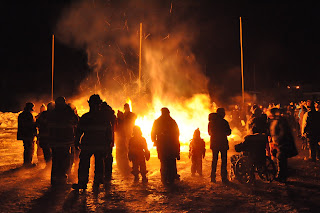
In what way is the light different?
We might not see the sun for 30 days in Inuvik, just its hints below the horizon, as it approaches, and then fades away. It's always an emotional moment when we encounter the sun after 30 days below the horizon. You don't get the dawn and twilight "golden hours", but you get sunshine in the middle of the night, which plays with your head. The return of winter means the chance to shoot Aurora Borealis. Around Inuvik, photography in low-light conditions abounds. Some of Philippe's favourite photos have been made in low-light conditions.
Coping with photography in mid-winter
 Cold-weather photography is a challenge. Batteries run out faster, and I have often heard a groan from my camera's autofocus, letting me know the mechanism is too cold to function. On very cold days, I carry my camera inside my coat on a very short neck strap. It stays warm by my chest, taking photos for brief bursts, and then returning the camera to the warmth. Having two batteries, and keeping them warm is essential. A trick learned here from local people: keep your mittens on a string for speedy recovery!
Cold-weather photography is a challenge. Batteries run out faster, and I have often heard a groan from my camera's autofocus, letting me know the mechanism is too cold to function. On very cold days, I carry my camera inside my coat on a very short neck strap. It stays warm by my chest, taking photos for brief bursts, and then returning the camera to the warmth. Having two batteries, and keeping them warm is essential. A trick learned here from local people: keep your mittens on a string for speedy recovery!
Are the people different up north?
Because there is "little to do", the arctic tends to filter out people who cannot entertain themselves. Living conditions encourage hobbies of extended, patient work, like sewing or beading. Most people, especially elders, have a hobby: they whittle; they make puzzles; they play cards - northerners are endless card players. One of my favourite images is of photographer Bern Will Brown, today in his 90s, in a small cabin in Colville Lake painting while smoking a pipe. He is an inspiration, and his book “A Time in the Arctic” is, for me, an essential book of photography in Canada.
Philippe has worked in and around the Inuvik community since 2006 as a reporter for CBC North. He shoots with a Nikon D90, but drools over the D200.
Julie Storry - Sydney Eye



